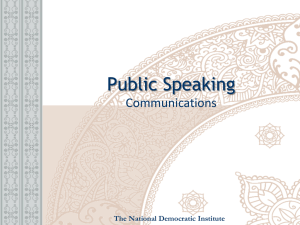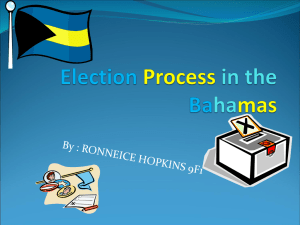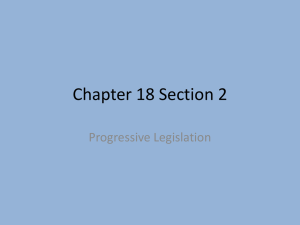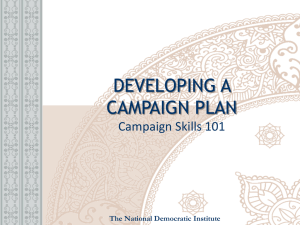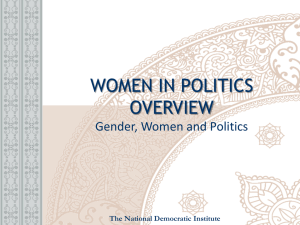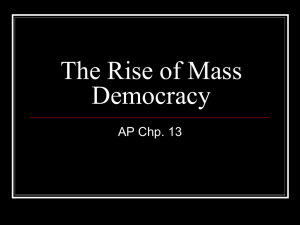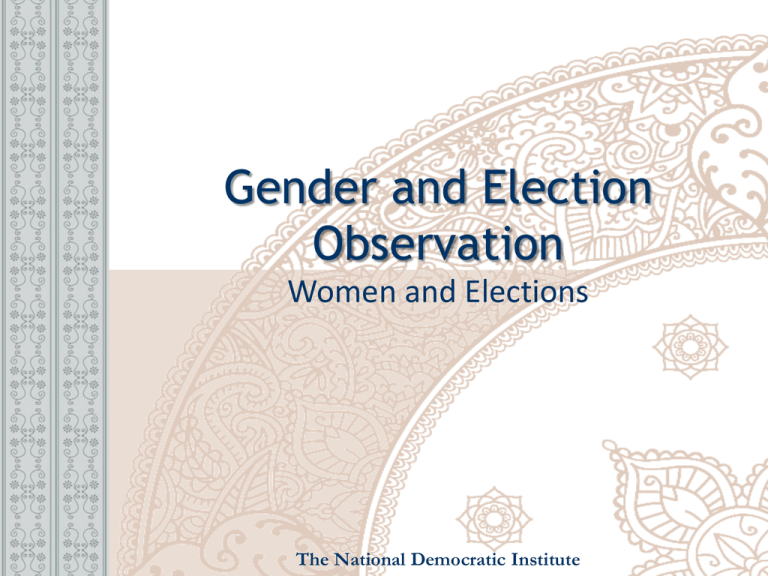
Gender and Election
Observation
Women and Elections
The National Democratic Institute
INTRODUCTIONS/
GROUND RULES
• Introductions
• Ground rules
• Ice breaker exercise
GENDER AND ELECTION
OBSERVATION OBJECTIVES
• To identify potential gender issues
related to the electoral process
• To increase knowledge of how to
incorporate gender aspects into
election observer trainings, materials
and reporting
GENDER AND ELECTION
OBSERVATION TOPICS
•
•
•
•
•
•
Pre-election monitoring
Observer team composition
Training for observers
Short-term observers
Domestic observers
Observer reporting
KEY TERMS
• Election
Observation
• Short Term/Long
Term/Domestic
Observation
Photo: NDI
• Gender Analysis
• Family/Proxy
Voting
• Gender-based
electoral violence
ELECTION OBSERVATION
• Conducted by parties, NGOs, the
media, government, international
organizations
• Can be domestic or international
• Partisan or non-partisan
Why observe elections?
Part of checks and balances
Encourages transparency
Assesses quality of elections
TYPES OF ELECTION
OBSERVATION
• Long Term Observers
(LTO)
• Short Term
Observers (STO)
• Domestic Observers
Photo: NDI
GENDER AND ELECTION
OBSERVATION
• Seeks gender equity for men and women
– Voters
– Candidates
– Election administrators
– Observers
Photo: NDI
WOMEN AS VOTERS
• Fundamental right
• Can face physical, logistical, social and
cultural barriers
Photo: NDI
PRE-ELECTION:
WOMEN VOTERS
• Voter registration process
• Disaggregate registration data by sex
and region
Photo: LBCherney, NDI
PRE-ELECTION:
VOTER EDUCATION
• Analyze voter education programs
• Determine particular voter education
needs
Photo: NDI
PRE-ELECTION: WOMEN
CANDIDATES
• Gender analysis of
election coverage
• Coverage of women
candidates
Photo: NDI
PRE-ELECTION: ELECTION
ADMINISTRATION
• Women in election
administration
• Leadership and
decision-making
roles
PRE-ELECTION: ELECTION
ADMINISTRATION
• Assess election administration’s gender
awareness and responsiveness
Photo: NDI
PRE-ELECTION
• Gender analysis of electoral dispute
resolution/complaint mechanisms
• Utilize women’s organizations
Civil Society Groups Can:
Be a resource on the context for
women’ s participation
May have information/ statistics
on women’s participation
EXAMPLE/ EXERCISE
• Morocco pre-election assessment of
2011 parliamentary election
Photo: Andrew Farrand, NDI
SHORT-TERM ELECTION DAY
OBSERVERS
• Polling station atmosphere and security
• Number of women on polling station
committee and sex of the chairperson
• Representation of women among party
poll-watchers
• Women voters’ level of understanding
of the procedures
• Sex-disaggregated voter data
SHORT-TERM ELECTION DAY
OBSERVERS
Voters turned away
Protections for secrecy of the vote
Instances of family or proxy voting
Instances of gender-based electoral
violence
• Compare voter rates at the central and
regional levels
•
•
•
•
DOMESTIC OBSERVATION
• Domestic groups positioned to identify
obstacles for women
• Trainings and materials should:
• highlight the importance of women’s
participation in elections
• provide a basic understanding of how
to observe gender-related issues and
possible irregularities
DOMESTIC OBSERVATION
• Incident report
forms should
include relevant
questions on
gender issues
• Questions should
be added to the
checklist
Photo: NDI
COMPOSITION OF OBSERVER
TEAMS
• Gender balance of
team members
• Include a gender
expert
Photo: NDI
Ensure someone is designated as
the gender focal point on the
team.
TRAINING FOR OBSERVERS
• Highlight importance of gender in the
training
• Identify potential barriers and how to
monitor these issues
• Include background information on
women’s participation
TRAINING FOR OBSERVERS
Include questions for monitoring
throughout process and Election Day:
Training materials
LTO weekly report templates
Election Day observer checklists
Photo: NDI
INTERVIEWS WITH KEY
STAKEHOLDERS
• What is the level of women’s
involvement in previous elections?
• What are the similarities and
differences between previous elections
and this one?
• What percentages of women are
registered and vote in comparison to
men? Is there a difference? If so, why?
INTERVIEWS WITH KEY
STAKEHOLDERS
• What are women’s voter participation
rates? How do they compare to men’s?
• Are there unique barriers to women’s
electoral participation? Have there
been any threats unique to women?
• Previous voter education and outreach
programs? By whom?
INTERVIEWS WITH KEY
STAKEHOLDERS
• Who are the key actors in election
monitoring?
• Is there a coalition?
• Are women/
women’s organizations
involved?
Photo: NDI
OBSERVATION STATEMENTS
• Participation of women as voters,
candidates
• Number of women elected (vs. previous
elections)
• Number of women in election
administration
• Gender-related security incidents
GENDER AND ELECTION
OBSERVATION REVIEW
• Pre-election
monitoring
• Short-term/election
day observers
• Domestic observation
• Observer training
• Observer Reporting
Photo: NDI
Questions?
Feedback?

